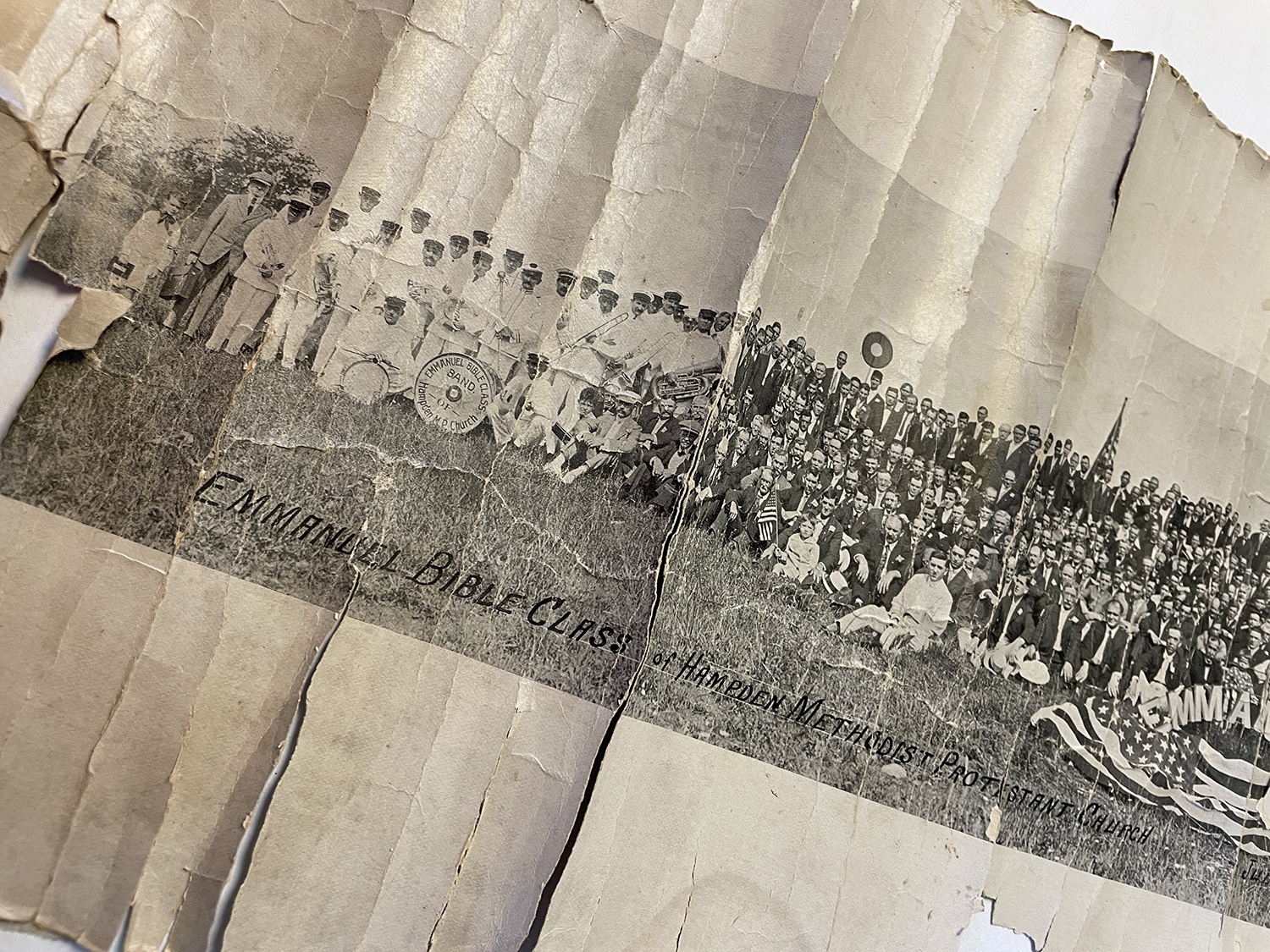
10 Jan What are Panoramic Photos?
You’ve discovered a tube in an attic, shoved in the corner of the closet, or in a box in the basement. When you pop off the top, you find a tightly wound document. It doesn’t want to come out because it has become one with the tube. After some gentle tugging and shimmying, the document slides out with a soft “pop.” You unroll an inch or two and discover a photograph. It could be a skyline or a group photo. You don’t get a great look because the photo starts to fight back—it wants to roll up again. You’re afraid to pull too hard, but your curiosity got the better of you. What do you have? This image is called a panoramic photo.
Panoramic photos are an all-hands-on-deck situation. Mary Lou starts tossing loupes, the magnifying glass, and the pen holder from the table to make more room for the photo. Two—sometimes three—sets of hands get to work slowly unrolling the tightly wound print. You know you have a fun photo when Mary Lou yells, “John, I need more room. Can you bring me another table?” It’s thrilling.
So, what is a panoramic photo? The simple answer: It’s a long, thin photo. Most people have seen one, or even posed in one. The technical answer is a panoramic photo is an ultra-wide view of a subject, wider than the human eye can see. Photographers create this image using a camera or software to stitch multiple exposures into one long photo.
In fact, photographers have been interested in panoramic photos since the advent of photography. Why? Let’s take a look:
History of Panoramic Photography
Early photographers were fascinated with the idea of panoramic images. They used photography to capture reality. A painting or sketch was an artist’s interpretation, a likeness. In comparison, photography was real, something a person physically saw. Naomi Rosenblum explains in “A World History of Photography”:
“While exposure time for the glass negative often remained long, the resulting sharply detailed segments of a scene, printed and glued together to form an encompassing view, were taken as embracing reality even though the human eye could not possibly have seen the landscape in that fashion.”
Photographers photographed a landscape in sections and lined their daguerreotypes (or other formats) side-by-side to create one long print, a panoramic photo. They used this technique to document history, and many antique landscapes are incredibly collectible today. The Library of Congress has an entire collection of panoramic images, some of them from the Civil War.
 This image was taken by George N. Barnard, a famous Civil War photographer. In this panoramic of Knoxville, you can clearly see the lines from each plate that are made into one long, thin photo. You can see the soldiers in the foreground and the town in the background. Each panel is interesting alone, but together, it makes the panoramic impressive. There are so many layers that one single panel cannot convey on its own.
This image was taken by George N. Barnard, a famous Civil War photographer. In this panoramic of Knoxville, you can clearly see the lines from each plate that are made into one long, thin photo. You can see the soldiers in the foreground and the town in the background. Each panel is interesting alone, but together, it makes the panoramic impressive. There are so many layers that one single panel cannot convey on its own.
Panoramic Photo Technology
The late 19th century brought with it cameras dedicated to panoramic photographs. These cameras used a swing lens or had 360-degree rotation. One of the most popular cameras debuted in 1904—the Kodak Cirkut camera.
The Cirkut camera used long format film ranging in size from 5”-16” in width to up to 20 feet long. It could create a 360-degree photograph. During the exposure, the film and the camera rotated on a special tripod mount. It was—and still is—the height of cool. Commercial photographers used the Cirkut camera to capture city views, group photos, and special events.
 Today, most people use panoramics in the same way—architecture, landscapes, group photos, special events, and other commercial purposes. Many graphic designers incorporate panoramic design elements into their web and print designs. You’ll often see long thin images running across a webpage or along a brochure, imitating a panoramic image. Some modern photographers have a camera that has in-camera panoramic stitching capabilities. Others use stitching software or crop photos to elongate them. Some cell phones can create panoramics, although the results vary.
Today, most people use panoramics in the same way—architecture, landscapes, group photos, special events, and other commercial purposes. Many graphic designers incorporate panoramic design elements into their web and print designs. You’ll often see long thin images running across a webpage or along a brochure, imitating a panoramic image. Some modern photographers have a camera that has in-camera panoramic stitching capabilities. Others use stitching software or crop photos to elongate them. Some cell phones can create panoramics, although the results vary.
Our photographer, John Coyle, points out that ultra-wide photography (including panoramics) can cause expanded imagery on the edges. “This sometimes includes distortion. A lot of this has to do with the lens. An inexpensive lens that is an ultra-wide angle will cause distortion. Higher quality lenses may not cause distortion, but may cause stretching,” adds John.
Tips for Panoramic Photos
Many panoramics come to us rolled in tubes or secured by rubber bands. If you find a tightly wound image, do not unroll it yourself. When a photo is tightly wound for an extended period of time, it freezes in that position. Paper has a memory and will want to return to its comfortable position. Unrolling it too fast and putting too much pressure on it will shock the chemistry, causing it to crack or break apart (i.e crazing). The best thing to do is to set it in a safe place until you can contact a pro to help unwind.
 There are some DIY solutions that involve a homemade humidity box. While this can be an effective treatment, not all photos are candidates for this method. Certain chemistries react negatively to moisture, and photos with existing damage will only escalate further. Introducing humidity can be risky if you don’t know what you’re doing. It’s best to consult with a pro before trying a homemade method.
There are some DIY solutions that involve a homemade humidity box. While this can be an effective treatment, not all photos are candidates for this method. Certain chemistries react negatively to moisture, and photos with existing damage will only escalate further. Introducing humidity can be risky if you don’t know what you’re doing. It’s best to consult with a pro before trying a homemade method.
If you decide to restore a panoramic, understand that this process takes longer than a typical restoration. These prints are usually very large and require time to relax. These images take longer to photograph and restore due to their size. If you have a panoramic and want to preserve it, the piece will need to remain flat. A conservator will either create a custom storage solution piece or house it in a frame. If you choose to frame it, you may want to consider conservation acrylic. Long thin prints and glass do not mix. Ask a pro if acrylic is best for your piece.
Some panoramic images are group photos from banquets, military units, church functions, etc. Many clients opt to photograph, restore, and print new copies for an institution or donate the original to the organization. Group photos have tremendous history in them. The photo may be a little large for your home, but an organization may want it for their archives or to display.
If you do decide to store or donate your panoramic photo, we can create a vignette of a person in a group photo. We isolate the individual and create a portrait out of the group photo image. This technique is particularly special if you do not have any photos of a person or only have a few.
Panoramic photos are intriguing. These images usually come with an interesting story. You always discover something new when you view a panoramic–it is hard to visually absorb all at once. Dig those photos out of your attics, closets, and basements for everyone to enjoy.
Want to learn more about photo history? Check out our guide to photo restoration.
